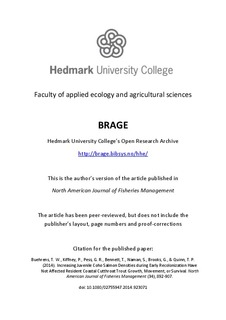| dc.contributor.author | Buehrens, Thomas | |
| dc.contributor.author | Kiffney, Peter | |
| dc.contributor.author | Pess, G.R. | |
| dc.contributor.author | Bennett, T.R. | |
| dc.contributor.author | Naman, S.M. | |
| dc.contributor.author | Brooks, G. | |
| dc.contributor.author | Quinn, T.P. | |
| dc.date.accessioned | 2015-02-27T10:59:52Z | |
| dc.date.available | 2015-02-27T10:59:52Z | |
| dc.date.issued | 2014 | |
| dc.identifier.citation | Buehrens, T. W., Kiffney, P., Pess, G. R., Bennett, T., Naman, S., Brooks, G., & Quinn, T. P. (2014). Increasing Juvenile Coho Salmon Densities during Early Recolonization Have Not Affected Resident Coastal Cutthroat Trout Growth, Movement, or Survival. North American Journal of Fisheries Management (34), 892-907. doi: 10.1080/02755947.2014.923071 | nb_NO |
| dc.identifier.uri | http://hdl.handle.net/11250/277991 | |
| dc.description.abstract | The process of salmon colonization in the upper Cedar River and Rock Creek, Washington, following the installation of a fish ladder at Landsburg Diversion Dam in 2003, offered an opportunity to measure the effects of interspecific interactions on the dynamics of resident fish populations. Rapid recolonization by Coho Salmon Oncorhynchus kisutch provided a natural experiment to determine the influence of Coho Salmon densities on the growth, movement, and survival of resident Coastal Cutthroat Trout O. clarkii clarkii relative to other abiotic and biotic factors such as habitat quality, environmental conditions, and conspecific density. During 14 seasonal sampling events from 2005 to 2009, we PIT-tagged 1,851 and recaptured 394 Cutthroat Trout in Rock Creek, collected habitat data, enumerated fish populations, and monitored fish movements with PIT tag antenna arrays. Trout growth varied significantly among seasons and was greatest during spring and early summer. Mean juvenile Coho Salmon density in summer and fall increased eightfold from 0.04 to 0.32 and from 0.08 to 0.68 fish/m2, respectively, approaching levels seen in established populations, but did not explain variation in trout growth, movement, or survival. Summer growth of trout parr and fry were both negatively correlated with the density of conspecifics but were positively correlated with total salmonid density. Additionally, trout parr growth was positively correlated with stream discharge, whereas trout fry growth was negatively correlated with initial size and declined during the course of the study. However, abiotic and biotic explanatory variables accounted for little of the variation in trout growth, movement, and survival, suggesting that a great deal of individual variation exists. Overall, trout were largely unaffected by Coho Salmon colonists despite large increases in juvenile Coho Salmon density, though this may change if salmon populations continue to grow. | nb_NO |
| dc.language.iso | eng | nb_NO |
| dc.publisher | Taylor & Francis | nb_NO |
| dc.relation.uri | http://www.tandfonline.com/doi/abs/10.1080/02755947.2014.923071#.VPBCTuGEcVQ | |
| dc.subject | cutthroat trout | nb_NO |
| dc.subject | coho salmon | nb_NO |
| dc.subject | competition | nb_NO |
| dc.subject | growth | nb_NO |
| dc.subject | movement | nb_NO |
| dc.subject | survival | nb_NO |
| dc.subject | recolonization | nb_NO |
| dc.title | Increasing Juvenile Coho Salmon Densities during Early Recolonization Have Not Affected Resident Coastal Cutthroat Trout Growth, Movement, or Survival | nb_NO |
| dc.type | Journal article | nb_NO |
| dc.type | Peer reviewed | nb_NO |
| dc.source.pagenumber | 892-907 | nb_NO |
| dc.source.volume | 34 | nb_NO |
| dc.source.journal | North American Journal of Fisheries Management | nb_NO |
| dc.identifier.doi | 10.1080/02755947.2014.923071 | |
